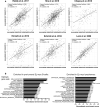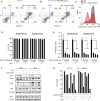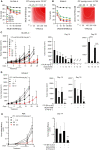Targeting mitochondrial respiration and the BCL2 family in high-grade MYC-associated B-cell lymphoma
- PMID: 34632715
- PMCID: PMC8895457
- DOI: 10.1002/1878-0261.13115
Targeting mitochondrial respiration and the BCL2 family in high-grade MYC-associated B-cell lymphoma
Abstract
Multiple molecular features, such as activation of specific oncogenes (e.g., MYC, BCL2) or a variety of gene expression signatures, have been associated with disease course in diffuse large B-cell lymphoma (DLBCL), although their relationships and implications for targeted therapy remain to be fully unraveled. We report that MYC activity is closely correlated with-and most likely a driver of-gene signatures related to oxidative phosphorylation (OxPhos) in DLBCL, pointing to OxPhos enzymes, in particular mitochondrial electron transport chain (ETC) complexes, as possible therapeutic targets in high-grade MYC-associated lymphomas. In our experiments, indeed, MYC sensitized B cells to the ETC complex I inhibitor IACS-010759. Mechanistically, IACS-010759 triggered the integrated stress response (ISR) pathway, driven by the transcription factors ATF4 and CHOP, which engaged the intrinsic apoptosis pathway and lowered the apoptotic threshold in MYC-overexpressing cells. In line with these findings, the BCL2-inhibitory compound venetoclax synergized with IACS-010759 against double-hit lymphoma (DHL), a high-grade malignancy with concurrent activation of MYC and BCL2. In BCL2-negative lymphoma cells, instead, killing by IACS-010759 was potentiated by the Mcl-1 inhibitor S63845. Thus, combining an OxPhos inhibitor with select BH3-mimetic drugs provides a novel therapeutic principle against aggressive, MYC-associated DLBCL variants.
Keywords: BCL2; DLBCL; Integrated Stress Response; MYC; OxPhos; chemotherapy.
© 2021 The Authors. Molecular Oncology published by John Wiley & Sons Ltd on behalf of Federation of European Biochemical Societies.
Conflict of interest statement
The authors declare no conflict of interest.
Figures







Similar articles
-
Targeting MYC activity in double-hit lymphoma with MYC and BCL2 and/or BCL6 rearrangements with epigenetic bromodomain inhibitors.J Hematol Oncol. 2019 Jul 9;12(1):73. doi: 10.1186/s13045-019-0761-2. J Hematol Oncol. 2019. PMID: 31288832 Free PMC article.
-
Clinical significance of 'double-hit' and 'double-expression' lymphomas.J Clin Pathol. 2020 Mar;73(3):126-138. doi: 10.1136/jclinpath-2019-206199. Epub 2019 Oct 15. J Clin Pathol. 2020. PMID: 31615842
-
Establishment and characterization of a novel MYC/BCL2 "double-hit" diffuse large B cell lymphoma cell line, RC.J Hematol Oncol. 2015 Oct 29;8:121. doi: 10.1186/s13045-015-0218-1. J Hematol Oncol. 2015. PMID: 26515759 Free PMC article.
-
The Spectrum of MYC Alterations in Diffuse Large B-Cell Lymphoma.Acta Haematol. 2020;143(6):520-528. doi: 10.1159/000505892. Epub 2020 Feb 19. Acta Haematol. 2020. PMID: 32074595 Review.
-
MYC in Germinal Center-derived lymphomas: Mechanisms and therapeutic opportunities.Immunol Rev. 2019 Mar;288(1):178-197. doi: 10.1111/imr.12734. Immunol Rev. 2019. PMID: 30874346 Review.
Cited by
-
Chronic lymphocytic leukemia patient-derived xenografts recapitulate clonal evolution to Richter transformation.Leukemia. 2024 Mar;38(3):557-569. doi: 10.1038/s41375-023-02095-5. Epub 2023 Nov 28. Leukemia. 2024. PMID: 38017105 Free PMC article.
-
Mitochondrial proteome landscape unveils key insights into melanoma severity and treatment strategies.Cancer. 2025 Jul 1;131(13):e35897. doi: 10.1002/cncr.35897. Cancer. 2025. PMID: 40545870 Free PMC article.
-
Oxidative stress enhances the therapeutic action of a respiratory inhibitor in MYC-driven lymphoma.EMBO Mol Med. 2023 Jun 7;15(6):e16910. doi: 10.15252/emmm.202216910. Epub 2023 May 9. EMBO Mol Med. 2023. PMID: 37158102 Free PMC article.
-
SETD8 inhibition targets cancer cells with increased rates of ribosome biogenesis.Cell Death Dis. 2024 Sep 28;15(9):694. doi: 10.1038/s41419-024-07106-6. Cell Death Dis. 2024. PMID: 39341827 Free PMC article.
-
PRPS activity tunes redox homeostasis in Myc-driven lymphoma.Redox Biol. 2025 Jul;84:103649. doi: 10.1016/j.redox.2025.103649. Epub 2025 Apr 25. Redox Biol. 2025. PMID: 40446642 Free PMC article.
References
-
- Liu Y & Barta SK (2019) Diffuse large B‐cell lymphoma: 2019 update on diagnosis, risk stratification, and treatment. Am J Hematol 94, 604–616. - PubMed
-
- Monti S, Savage KJ, Kutok JL, Feuerhake F, Kurtin P, Mihm M, Wu B, Pasqualucci L, Neuberg D, Aguiar RC et al. (2005) Molecular profiling of diffuse large B‐cell lymphoma identifies robust subtypes including one characterized by host inflammatory response. Blood 105, 1851–1861. - PubMed
Publication types
MeSH terms
Substances
LinkOut - more resources
Full Text Sources
Molecular Biology Databases
Research Materials

